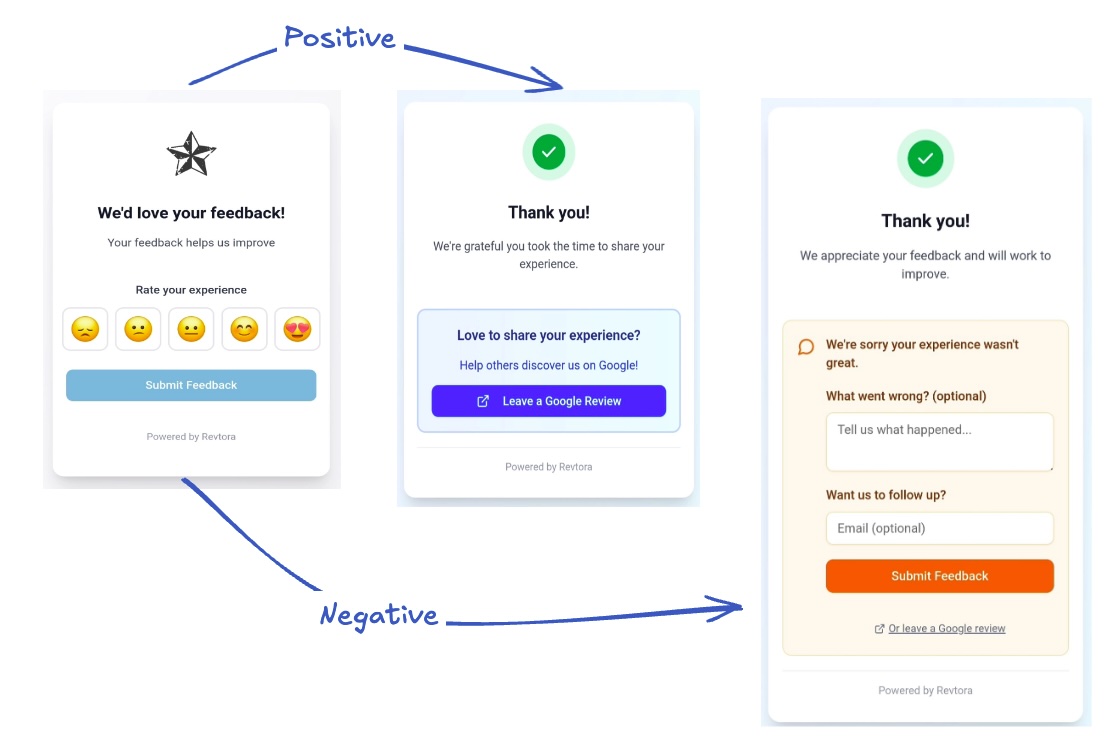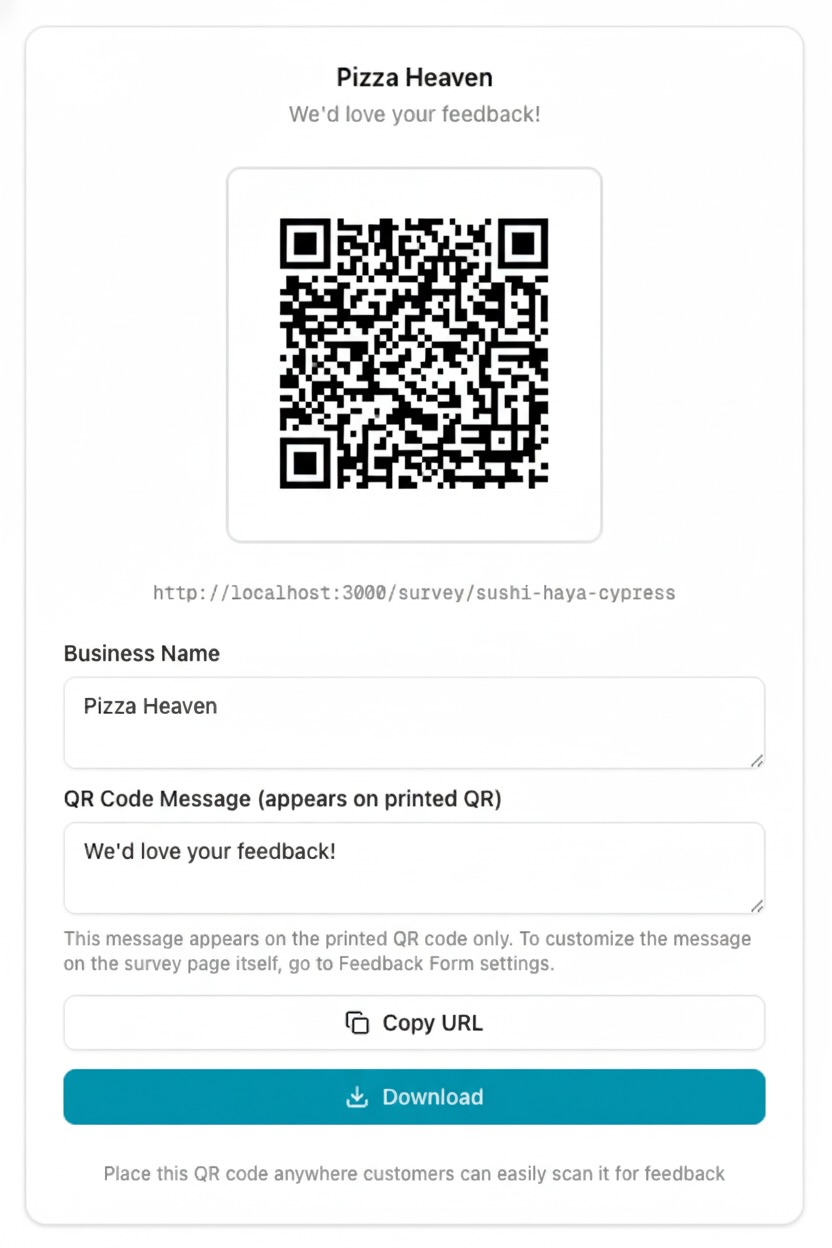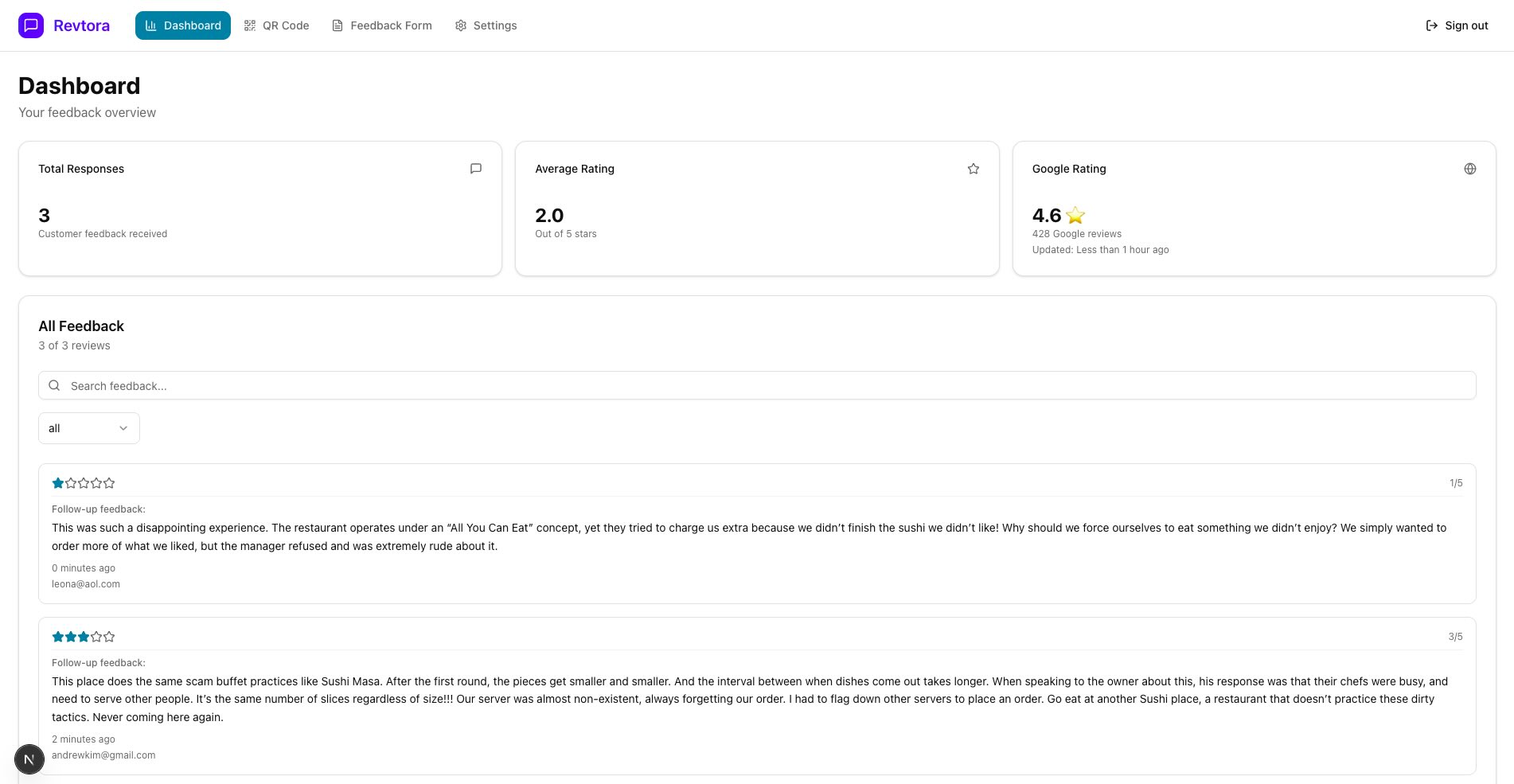How to Get More Google Reviews: The QR Code Method That Actually Works [2025]
Discover the proven QR code strategy that helps local businesses get 3x more Google reviews. Learn how smart review filtering protects your reputation while growing your 5-star ratings.

How to Get More Google Reviews: The QR Code Method That Actually Works [2025]
Getting more Google reviews shouldn't feel like pulling teeth. Yet most local business owners struggle to collect genuine feedback from their happy customers—while negative reviews seem to appear out of nowhere.
Here's the reality: 87% of consumers read online reviews for local businesses, and Google reviews directly impact your local search rankings. If you're not actively collecting reviews, you're invisible to potential customers.
But there's good news. The QR code method has become the secret weapon for smart local businesses in 2025. It's simple, friction-free, and when done right, it can triple your review count in just a few months.
In this guide, you'll learn exactly how to implement a QR code review system that not only gets you more reviews but also protects your reputation from damaging feedback.
Why Traditional Review Requests Don't Work
Before we dive into the solution, let's talk about why most businesses struggle with reviews.
Common mistakes business owners make:
-
Sending generic email requests days after the customer experience
-
Asking for reviews on social media where people scroll past
-
Relying on staff to "remember" to ask customers
-
Making the process too complicated (too many clicks, too much friction)
-
Having no system to filter out potentially negative feedback before it goes public
The biggest problem? Timing and convenience. By the time a customer gets home, opens their email, and sees your review request, they've moved on. The moment of excitement has passed.
The QR Code Advantage: Why It Works
QR codes solve the fundamental problem of review collection: they capture feedback at the moment of peak satisfaction.
Think about it. Your customer just had an amazing experience at your restaurant, spa, auto shop, or salon. They're happy, they're standing right there, and they have their phone in their hand.
What makes QR codes so effective:
-
Zero friction - One scan, no typing required
-
Instant action - Captures the moment when emotions are highest
-
Mobile-first - Everyone has their phone ready
-
No memorization needed - No need to remember your business name later
-
Trackable - You can measure exactly how many scans convert to reviews
Studies show that review requests made within 24 hours of service get 3x higher response rates than those sent days later. QR codes let you ask in real-time.
The Smart Review Filtering Strategy
Here's where most businesses get it wrong: they send everyone directly to Google, good experience or bad.
Smart local businesses in 2025 use a two-step filtering approach:
Step 1: Quick Satisfaction Survey
When customers scan your QR code, they first see a simple rating screen:
- How was your experience? (⭐⭐⭐⭐⭐)
Step 2: Smart Routing
Happy customers (4-5 stars):
-
Automatically directed to your Google Business Profile review page
-
These are your promoters—make it easy for them to share their experience
Unhappy customers (1-3 stars):
-
Directed to a private feedback form
-
Can optionally share their email for follow-up
-
Gives them a chance to voice concerns directly to you
-
Prevents negative reviews from going public while they're upset
-
Allows you to resolve issues and potentially earn their business back
Why this works: You're not hiding from feedback—you're being smart about reputation management. Happy customers love to share publicly, but dissatisfied customers often just want to be heard and have their issue resolved. Give them a private channel to do that, then follow up to make it right.

How it works in practice: When customers scan your QR code and rate their experience, happy customers (4-5 stars) go straight to Google to leave a public review. Unhappy customers (1-3 stars) are given a private feedback form where they can share what went wrong—and optionally provide their email so you can follow up and resolve the issue. You respond to all public Google reviews through your Google Business Profile as normal, while using your dashboard to track private feedback and reach out to unhappy customers directly.
How to Set Up Your Google Review QR Code System
Let's get tactical. Here's your step-by-step implementation guide.
Step 1: Create Your Google Review Link
First, you need your direct Google Business Profile review link.
Here's how to get it:
-
Go to Google Business Profile
-
Sign in to your business account
-
Click on your business location
-
Look for "Get more reviews" or "Ask for reviews"
-
Copy the short review link provided
Your link will look something like: https://g.page/r/[unique-code]/review
Step 2: Generate Your QR Code
You have two options here:
Option A: Basic QR Code (Free)
-
Use a free QR generator like QR Code Generator or Adobe's tool
-
Paste your Google review link
-
Download the QR code image
-
Downside: Everyone goes directly to Google (no filtering)
Option B: Smart Filtering System
-
Use a review management platform like Revtora
-
Built-in satisfaction survey
-
Automatic routing based on rating
-
Dashboard to track private feedback and follow up with customers (if they share contact info)
-
Advantage: Protects your online reputation by giving unhappy customers a private channel
Note: You'll still respond to public Google reviews directly through your Google Business Profile. The dashboard helps you track and address private feedback before it becomes a public issue.

Step 3: Design Your QR Code Materials
Your QR code needs to be visible and inviting. Here are the best placements:
For Restaurants & Cafes:
-
Table tent cards
-
Receipt inserts
-
Menu corners
-
Takeout bag stickers
For Retail Stores:
-
Checkout counter displays
-
Shopping bag inserts
-
Product packaging
-
Store window decals
For Service Businesses (Salons, Auto Repair, Spas):
-
Lobby waiting area posters
-
Appointment reminder cards
-
Thank-you cards with service
-
Email signatures
Design tips:
-
Keep it simple—just the QR code and clear text: "Loved your experience? Share it!"
-
Use your brand colors
-
Make the QR code large enough (at least 2x2 inches)
-
Test it before printing (scan with multiple phones)
-
Add a small incentive mention if appropriate (e.g., "Your feedback helps us serve you better")
Step 4: Train Your Team
Your staff is your secret weapon. They need to know:
What to say:
-
"We'd love to hear about your experience today! Would you mind scanning this QR code?"
-
"Your feedback really helps us improve. It takes just 30 seconds."
-
NOT: "Can you give us a 5-star review?" (This violates Google's guidelines)
When to ask:
-
After completing service
-
During checkout
-
When customer expresses satisfaction
-
NOT: When there's been an issue (unless resolved)
How to present it:
-
Keep cards visible at checkout
-
Have it displayed in waiting areas
-
Include in follow-up texts or emails as backup
Step 5: Follow Up (But Don't Spam)
The QR code is your primary method, but follow-up matters:
24-hour follow-up email:
Subject: Thanks for visiting [Business Name]!
Hi [Customer Name],
Thank you for choosing [Business Name] today. We hope you loved [specific service/product].
If you have 30 seconds, we'd really appreciate your feedback:
[QR Code Image] or [Review Link]
Your insights help us improve and help others discover us too.
Thanks again!
[Your Name]
Keep it simple:
-
One email only (no repeat requests)
-
Include the same QR code
-
Personalize when possible
-
Make it mobile-friendly
Responding to Reviews: The Make-or-Break Factor
Getting reviews is only half the battle. Responding to them shows you're engaged and care about feedback.
Responding to Positive Reviews
Template structure:
Thank [Reviewer Name] by name
→ Mention specific detail from their review
→ Invite them back
Example:
"Thanks so much, Sarah! We're thrilled you loved the new latte special. Maria will be happy to hear you enjoyed her service. See you soon!"
Responding to Negative Reviews
Yes, even with filtering, some negative reviews will appear. Here's how to handle them:
The 3-part response:
- Acknowledge & apologize
- "We're sorry to hear about your experience."
- Address the specific issue
- "We take [specific complaint] seriously and are looking into it."
- Take it offline
- "Please contact us at [phone/email] so we can make this right."
Never:
-
Get defensive
-
Make excuses
-
Argue in public
-
Ignore it

Advanced Tactics: Maximizing Your Results
Once you have the basics down, level up with these strategies:
1. Create Location-Specific QR Codes
If you have multiple locations, use unique QR codes for each. This helps you:
-
Track which locations are performing best
-
Identify training opportunities
-
Customize messaging per location
2. A/B Test Your Messaging
Try different calls-to-action:
-
"Share your experience" vs. "Help others find us"
-
"Leave a review" vs. "Tell us how we did"
-
Track which language gets better response rates
3. Integrate with Your CRM
Connect your review system to your customer database:
-
Auto-send review requests after completed purchases
-
Segment by customer loyalty (VIP customers get personal asks)
-
Track review rate per customer segment
4. Incentivize (The Right Way)
Legal incentives:
-
Entry into monthly drawing for leaving ANY review
-
Small thank-you gift for feedback (not tied to positive reviews)
-
Loyalty points for participation
Illegal/Against TOS:
-
Discounts for 5-star reviews only
-
Payment for positive reviews
-
Punishment for negative reviews
5. Feature Your Reviews Everywhere
Once you get them, use them:
-
Display on your website with a Google review widget
-
Share in social media posts (with permission)
-
Include in email newsletters
-
Add to print marketing materials
Common Mistakes to Avoid
Don't sabotage your own efforts. Avoid these pitfalls:
❌ Asking for "5-star reviews" specifically
-
Google forbids incentivizing specific ratings
-
Sounds desperate and inauthentic
❌ Buying fake reviews
-
Violates FTC guidelines
-
Google detects and removes them
-
Destroys your credibility
❌ Making it too complicated
-
Multiple steps kill conversion
-
Keep it to: Scan → Rate → Review
❌ Only asking top customers
-
Creates bias in your reviews
-
You want authentic representation
❌ Ignoring the reviews you get
-
No response = no engagement
-
Future customers are watching
Measuring Success: Key Metrics to Track
How do you know if your QR code strategy is working?
Track these metrics:
- QR Code Scan Rate
-
How many people scan vs. how many you hand out
-
Target: 20-30% scan rate
- Review Conversion Rate
-
Scans that turn into actual reviews
-
Target: 30-40% of scans
- Overall Review Growth
-
Month-over-month increase in total reviews
-
Target: 10-20 new reviews per month (for small businesses)
- Average Star Rating
-
Your overall rating trend
-
Target: Maintain or improve (goal: 4.5+)
- Private Feedback Volume
-
How many unhappy customers you're catching before they post publicly
-
Track follow-up rate (how many you reached out to)
-
Success metric: Issues resolved = potential negative reviews prevented
Review these monthly and adjust your strategy accordingly.
Real Results: What to Expect
When implemented correctly, here's what you can realistically achieve:
Month 1:
-
5-10 new reviews (as you roll out and train staff)
-
Initial team buy-in and system testing
Months 2-3:
-
15-25 new reviews per month
-
Staff becomes comfortable with the ask
-
You refine placement and messaging
Months 4-6:
-
20-30+ new reviews per month (steady state)
-
Improved local search rankings
-
Noticeable increase in organic traffic from Google
After 6 months:
-
100+ new reviews
-
Higher trust and conversion rates
-
Competitive advantage in local search
Your Action Plan: Get Started Today
Ready to implement? Here's your immediate next steps:
Today:
-
Get your Google review link from your Business Profile
-
Generate your QR code (or sign up for a filtering platform)
-
Design your first materials (start with checkout counter cards)
This Week:
-
Print your QR code materials
-
Train your team on when and how to ask
-
Place QR codes in high-traffic areas
-
Send your first follow-up email with the QR code
This Month:
-
Respond to every review you receive
-
Track your metrics (scans, reviews, ratings)
-
Refine your approach based on results
-
Expand QR code placements based on what works
The Bottom Line
Getting more Google reviews isn't about tricking people or begging customers. It's about making it easy and natural for happy customers to share their experiences.
The QR code method works because it:
-
Captures feedback at the perfect moment
-
Removes all friction from the review process
-
Protects your reputation through smart filtering
-
Scales without requiring constant manual effort
Most importantly, it respects your customers' time while giving you the reviews you need to grow.
Start with one QR code placement this week. Train your team. Ask your customers. You'll be surprised how willing people are to help when you make it this easy.
Your reputation is your most valuable asset. Protect it, grow it, and watch your business thrive.
Frequently Asked Questions
How many Google reviews do I need to rank higher?
While there's no magic number, businesses with 50+ reviews tend to see significant SEO benefits. Focus on steady, consistent growth (10-20 reviews per month) rather than trying to get hundreds overnight.
Is it legal to use a review filtering system?
Yes, as long as you're not preventing customers from leaving negative reviews on Google if they choose to. Filtering systems offer an alternative feedback channel—customers can always search for and review your business independently.
What if someone leaves a fake negative review?
Report it to Google through your Business Profile. If it violates Google's review policies (spam, fake, conflict of interest), they'll remove it. Document evidence if you suspect it's a competitor or fake account.
Should I respond to every single review?
Yes, if possible. Even a simple "Thank you!" shows you're engaged. Prioritize responding to negative reviews first, then detailed positive ones, then brief thank-yous for shorter reviews.
How long does it take to see SEO results from more reviews?
You'll typically start seeing improved local search rankings within 2-3 months of consistent review growth. Google's algorithm updates regularly, so patience and consistency are key.
Can I delete negative reviews?
No, you cannot delete legitimate negative reviews. You can only flag ones that violate Google's policies. Focus instead on responding professionally and earning more positive reviews to offset them.
Ready to get started with a smart review system? Check out how Revtora helps local businesses collect more 5-star reviews while protecting their reputation with built-in filtering and private feedback tracking—all through one simple QR code.